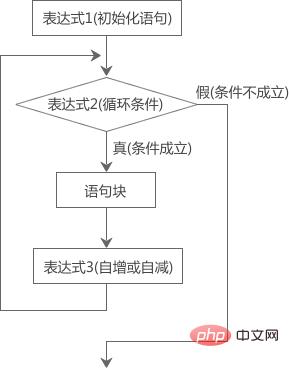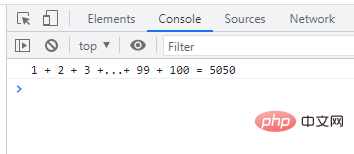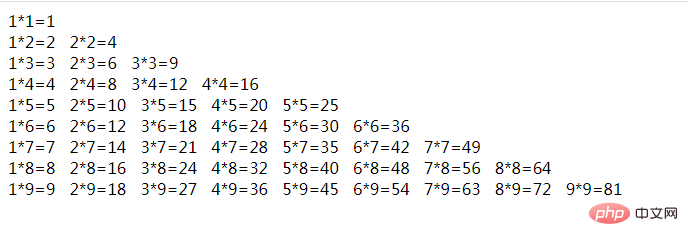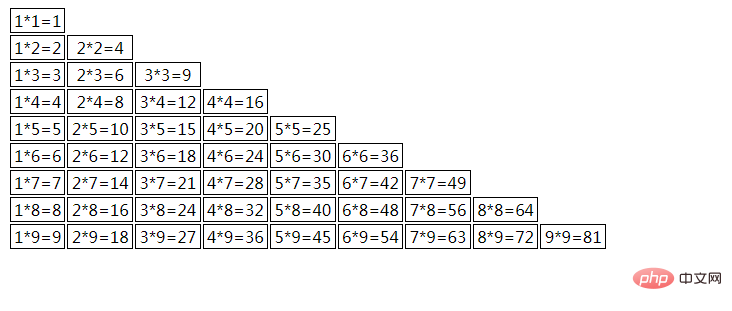JS loop learning: use of for loop statements (detailed examples)
In the previous article "JS Loop Learning: The Use of While Loop Statements (Detailed Examples)", we briefly learned about the while loop and the do while loop, and today we will introduce another loop—— for loop statement, hope it helps everyone!

1: for loop
The for loop will pre-define the variable that controls the number of loops in for statement, so the for loop statement can perform loop operations according to the known number of loops, which is suitable for situations where the number of times the script needs to be run is clearly known.
The syntax format of the for loop is as follows:
for (初始化语句; 循环条件; 变量更新--自增或自减) {
语句块;
}The for loop statement can be disassembled into 4 parts: three of the () Expressions and "statement blocks" in {}, let's analyze them below.
Statement analysis:
Initialization statement (expression 1): mainly initializes a variable value, used to set a counter, that is, the value at the beginning of the loop ; This statement is only executed during the first loop and will not be executed again in the future.
Loop condition (expression 2): Restriction condition for loop execution, used to control whether to execute the code in the loop body; if the condition is TRUE, the loop continues, if the condition is FALSE , the loop ends and exits the loop immediately.
Variable update (expression 3): an expression with an increment or decrement operation. Every time the loop is executed, the value of the counter is immediately modified so that the loop The conditions gradually become "untenable".
Statement block: Several codes that need to be executed when the condition is judged to be true.
Is the above description a bit convoluted? Let’s take a look at the execution flow chart of the for loop statement to understand the execution of the for loop more intuitively. Process:

# Now that we understand the execution process of the for loop, let’s do the actual operation and do a small question to see if we have mastered it!
Example: Calculate the sum from 1 to 100
<script type="text/javascript">
var sum=0;
for(var i=1; i<=100; i++){
sum+=i;
}
console.log('1 + 2 + 3 +...+ 99 + 100 = '+sum);
</script>
##Three expressions in a for loop
JS The three expressions in brackets in the for loop can be omitted, but the semicolon used to separate the three expressions cannot be omitted, as shown in the following example:// 省略第一个表达式
var i = 0;
for (; i < 5; i++) {
// 要执行的代码
}
// 省略第二个表达式
for (var y = 0; ; y++) {
if(y > 5){
break;
}
// 要执行的代码
}
// 省略第一个和第三个表达式
var j = 0;
for (; j < 5;) {
// 要执行的代码
j++;
}
// 省略所有表达式
var z = 0;
for (;;) {
if(z > 5){
break;
}
// 要执行的代码
z++;
}2: For loop nesting
No matter what kind of loop, it can be nested (that is, one or more loops can be defined in a loop).Grammar format:
for (初始化语句1; 循环条件; 变量更新--自增或自减) {
//语句块1;
for (初始化语句2; 循环条件; 变量更新--自增或自减) {
//语句块2;
for (初始化语句3; 循环条件; 变量更新--自增或自减) {
//语句块3;
.....
}
}
}Here, we define three nestings of for loops. Of course, we can nest as many for loops as we want. .
Case: for loop to implement multiplication table
First of all, let’s observe the multiplication table 
- There are a total of 9 rows and 9 columns, and there are several expressions in each row.
- In line i, the expression starts from i*1 and ends at i*i. There are a total of i expressions (we can achieve this effect through a loop).
for(var i = 1; i <= 9; i++){ //外层循环控制行
for(var j = 1; j <= i; j++) //内层循环控制列
{
document.write(j+"*"+i+"="+j*i+" ");
}
document.write("</br>");
}
document.write("<table>");
for (var i = 1; i <= 9; i++) { //外层循环控制行
document.write("<tr>");
for (var j = 1; j <= i; j++) //内层循环控制列
{
document.write("<td>" + j + "*" + i + "=" + j * i + "</td>");
}
//换行,控制每行的输出几个表达式
document.write("</tr>");
}
document.write("</table>");table {
width: 600px;
border-collapse: separate;
}
table td {
border: #000 1px solid;
text-align: center;
}
javascript advanced tutorial]
The above is the detailed content of JS loop learning: use of for loop statements (detailed examples). For more information, please follow other related articles on the PHP Chinese website!

Hot AI Tools

Undresser.AI Undress
AI-powered app for creating realistic nude photos

AI Clothes Remover
Online AI tool for removing clothes from photos.

Undress AI Tool
Undress images for free

Clothoff.io
AI clothes remover

AI Hentai Generator
Generate AI Hentai for free.

Hot Article

Hot Tools

Notepad++7.3.1
Easy-to-use and free code editor

SublimeText3 Chinese version
Chinese version, very easy to use

Zend Studio 13.0.1
Powerful PHP integrated development environment

Dreamweaver CS6
Visual web development tools

SublimeText3 Mac version
God-level code editing software (SublimeText3)

Hot Topics
 1377
1377
 52
52
 How to implement an online speech recognition system using WebSocket and JavaScript
Dec 17, 2023 pm 02:54 PM
How to implement an online speech recognition system using WebSocket and JavaScript
Dec 17, 2023 pm 02:54 PM
How to use WebSocket and JavaScript to implement an online speech recognition system Introduction: With the continuous development of technology, speech recognition technology has become an important part of the field of artificial intelligence. The online speech recognition system based on WebSocket and JavaScript has the characteristics of low latency, real-time and cross-platform, and has become a widely used solution. This article will introduce how to use WebSocket and JavaScript to implement an online speech recognition system.
 WebSocket and JavaScript: key technologies for implementing real-time monitoring systems
Dec 17, 2023 pm 05:30 PM
WebSocket and JavaScript: key technologies for implementing real-time monitoring systems
Dec 17, 2023 pm 05:30 PM
WebSocket and JavaScript: Key technologies for realizing real-time monitoring systems Introduction: With the rapid development of Internet technology, real-time monitoring systems have been widely used in various fields. One of the key technologies to achieve real-time monitoring is the combination of WebSocket and JavaScript. This article will introduce the application of WebSocket and JavaScript in real-time monitoring systems, give code examples, and explain their implementation principles in detail. 1. WebSocket technology
 How to use JavaScript and WebSocket to implement a real-time online ordering system
Dec 17, 2023 pm 12:09 PM
How to use JavaScript and WebSocket to implement a real-time online ordering system
Dec 17, 2023 pm 12:09 PM
Introduction to how to use JavaScript and WebSocket to implement a real-time online ordering system: With the popularity of the Internet and the advancement of technology, more and more restaurants have begun to provide online ordering services. In order to implement a real-time online ordering system, we can use JavaScript and WebSocket technology. WebSocket is a full-duplex communication protocol based on the TCP protocol, which can realize real-time two-way communication between the client and the server. In the real-time online ordering system, when the user selects dishes and places an order
 How to implement an online reservation system using WebSocket and JavaScript
Dec 17, 2023 am 09:39 AM
How to implement an online reservation system using WebSocket and JavaScript
Dec 17, 2023 am 09:39 AM
How to use WebSocket and JavaScript to implement an online reservation system. In today's digital era, more and more businesses and services need to provide online reservation functions. It is crucial to implement an efficient and real-time online reservation system. This article will introduce how to use WebSocket and JavaScript to implement an online reservation system, and provide specific code examples. 1. What is WebSocket? WebSocket is a full-duplex method on a single TCP connection.
 JavaScript and WebSocket: Building an efficient real-time weather forecasting system
Dec 17, 2023 pm 05:13 PM
JavaScript and WebSocket: Building an efficient real-time weather forecasting system
Dec 17, 2023 pm 05:13 PM
JavaScript and WebSocket: Building an efficient real-time weather forecast system Introduction: Today, the accuracy of weather forecasts is of great significance to daily life and decision-making. As technology develops, we can provide more accurate and reliable weather forecasts by obtaining weather data in real time. In this article, we will learn how to use JavaScript and WebSocket technology to build an efficient real-time weather forecast system. This article will demonstrate the implementation process through specific code examples. We
 Simple JavaScript Tutorial: How to Get HTTP Status Code
Jan 05, 2024 pm 06:08 PM
Simple JavaScript Tutorial: How to Get HTTP Status Code
Jan 05, 2024 pm 06:08 PM
JavaScript tutorial: How to get HTTP status code, specific code examples are required. Preface: In web development, data interaction with the server is often involved. When communicating with the server, we often need to obtain the returned HTTP status code to determine whether the operation is successful, and perform corresponding processing based on different status codes. This article will teach you how to use JavaScript to obtain HTTP status codes and provide some practical code examples. Using XMLHttpRequest
 How to use insertBefore in javascript
Nov 24, 2023 am 11:56 AM
How to use insertBefore in javascript
Nov 24, 2023 am 11:56 AM
Usage: In JavaScript, the insertBefore() method is used to insert a new node in the DOM tree. This method requires two parameters: the new node to be inserted and the reference node (that is, the node where the new node will be inserted).
 How to get HTTP status code in JavaScript the easy way
Jan 05, 2024 pm 01:37 PM
How to get HTTP status code in JavaScript the easy way
Jan 05, 2024 pm 01:37 PM
Introduction to the method of obtaining HTTP status code in JavaScript: In front-end development, we often need to deal with the interaction with the back-end interface, and HTTP status code is a very important part of it. Understanding and obtaining HTTP status codes helps us better handle the data returned by the interface. This article will introduce how to use JavaScript to obtain HTTP status codes and provide specific code examples. 1. What is HTTP status code? HTTP status code means that when the browser initiates a request to the server, the service




